Metasequoia glyptostroboides



Furrowed
Having thick bark forming furrows .
Conical / Pyramidal
When the outline of a shrub or tree forms a cone or pyramidal shape.This deciduous conifer has a buttress base with a straight trunk. The red bark turns grey-black and comes away in stringy strips. The graceful spreading branches forming a conical habit with small bright green linear leaves that turns yellow-brown in autumn.
Metasequoia glyptostroboides Hu & W.C.Cheng, was thought to be extinct until it was discovered in 1941 in eastern Sichuan and Hubei provinces in China. It was found in moist valley floors at the base of mountain cliffs commonly along river embankments appearing at an elevation from 750 m (2,460 ft) to 1,500 m (4,921 ft). It is regarded as endangered and has been propagated then introduced to Europe, the U.S. and many other countries. It prefers a well drained deep moist sandy to clay or loamy soil that is acidic to slightly alkaline with a pH range from 5.0 to 7.5 and will tolerate chalky soils. It grows in a open sunny to semi shaded position and is drought tender, shade intolerant but frost and snow tolerant. Its preferred minimum winter temperature is -15ºC (5ºF) and an optimum summer temperature from 18ºC (65ºF) to 27ºC (80ºF).
Dawn Redwood is grown for its conical habit and its autumn foliage colour. It is planted in parks and large gardens as a specimen tree or used as a focal point in a formal garden. It is also planted along borders as a summer screen and is used as a large street plantings as it is pollution tolerant. It has a medium growth rate establishing in 4 to 7 years as a small tree and is long lived maturing in 200 years. It is also used as a bonsai subject and can be grown in large pots and tubs when young. Once established it has a high water requirement (Scale: 3-drops from 3), preferring organic rich deep soil that is reliably moist and tolerates periodic inundation.
I.D. 223
UK hardiness zone H6
Climate zones 3 - 10, 14 - 24
USDA Zone 5-10
Metasequoia (me-ta-se-KWOY-a) glyptostroboides (glip-to-stro-BOI-deez)
Etymology
Genus: - Greek- Metasequoia - from ‘meta’ meaning (associated with) and ‘Sequoia’ (type of tree species) which implies that this is not a true Sequoia
Species: Greek - glyptostroboides – from ’ glypto’ meaning (carved) and ‘strobus’ meaning (a fruit) and ‘oides’ meaning (resembling) referring to the cones look like wood carvings.
Note; the large buttress trunk can reach a width of 8m (26ft) (rare) and the rust-coloured bark is deeply furrowed and flaky shedding in strips.
In its natural habitat the tree is under threat from expansion of rice fields. In the past it was heavily logged leading to almost its extinction. It was first described from fossil material and was only discovered in 1941.
Cultivar
'Miss Grace'
This dwarf coniferous shrub grows to 2.5 m (8 ft) tall by 1 m (3 ft) wide over a 10 year period with an upright trunk and graceful weeping branches. It has grey-green foliage that turns deep orange during autumn and grows in an open sunny to partially shaded protected position. It prefers a well-drained moist fertile soil and grows in USDA zones 4 - 6.
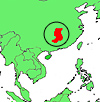
China (Sichuan and Hubei provinces)
Cupressaceae (kew-press-AY-see-ee)
Coniferous Trees
This family consists of evergreen shrubs and trees that are monoecious or dioecious and are normally columnar to conical shape with scale or needle-like leaves on 4 angled, terete or flattened branches.
Distribution
Mainly found in the northern hemisphere with a concentration in North America, Europe and Russia appearing in a wide range of habitats from alpine to arid, from sea level to high altitudes.
Diagnostic Features
The leaves are simple, linear and needle-like particularly in the juvenile stage and commonly with an abaxial resin glands or are scale-like and keeled, adherent to the internode on the stem. They are arranged in alternately pairs (decussate) or in whorls of three.
These plants may be monoecious or dioecious with the pollen male cones arranged terminally or axillary, normally solitary and shedding annually. There are 6-16 microsporophylls that are decussate or whorled and normally have 3 - 6 pollen sacs that release wingless pollen.
The female seed cones normally appear terminal at the tip of the branches and are solitary, globose, oblong or ovoid and are dehiscent or indehiscent when mature in 1st, 2nd or 3rd year. The cone scales are fleshy when young maturing to a woody leathery or succulent texture and are arranged peltate (on a central axis) or valvate with one to three whorls that are fused at the base. There are one to twelve ovules at the base of each scale and are erect.
The seeds are winged or not and the wings are derived from the hard seed coat with only a few fertile per cone.
Note:
Some species of Callitris are used for their termite resistant timber and other species are used for building bridges or ships, furniture and for paper production. They are also grown ornamentally in parks and gardens.
This plant tolerates between USDA zones 5a to 10a and grows to 60 m (140 ft)
Fahrenheit -20º to 35º F
These temperatures represent the lowest average.
Celsius -26.2º to 1.6º C

Attention
This plant was last revised on the 12/05/2024
All photographs and data are covered by copyright. Apart from any fair dealing for the purpose of private study, research, reference or review, as permitted under the Copyright Act, no part including images and text may be reproduced by any means without written permission. The information presented in the map is only indicative and may contain errors and omissions. All inquiries should be addressed to sales@plantfile.com attention Peter Kirkland.

Simple
The leaf that is not divided.
Linear
Margins are parallel and length is ten times its breadth.
Opposite
Leaves that are arranged opposite to each other.
Entire
A leaf margin with no irregularities (smooth).There are 20 to 30 pairs of soft textured 15 mm (2/3 in) long linear leaves arranged on one plane. The mid vein on the upper surface is slightly grooved and the underside has faint glaucous lines of stomata. During autumn they turn yellows-red and the twigs that hold the leaves are shed.
Note:
The buds may occur solitary or in pairs and are ovoid up to 6 mm (¼ in) long. The scales are yellowish-brown appearing beneath the twigs and not in the axils.

Strobilus
A cone-like structure with an axis bearing sporophylls.
Catkin
A raceme-like inflorescence, often pendulous, unisexual, the flowers are enclosed in the axils by scaly bracts and pollination occurs by wind.| Jan | Feb | Mar | Apr | May | Jun |
| Jul | Aug | Sep | Oct | Nov | Dec |
The male flowers are very small and arranged in a raceme or panicle that is up to 300 mm (1 ft) long and not commonly seen and the female flowers are produced when the leaves first emerge and appear solitary during early spring.
Note:
Metasequoia glyptostroboides is a monoecious gymnosperm, which produces unprotected ovules on the megasporophylls; these are normally arranged in cones.

Cone
A conical multiple fruit consisting of valvate scales having naked ovules or seeds. A strobilus. "| Jan | Feb | Mar | Apr | May | Jun |
| Jul | Aug | Sep | Oct | Nov | Dec |
The 45 mm (1 ¾ in) long stalked pendulous cones are round to ovoid with up to 28 scales. Each scale produces up to 8 winged seeds. The seeds are viable but the plant may be reproduced vegetatively.
Dawn Redwood is grown for its conical habit and its autumn foliage colour. It is planted in parks and large gardens as a specimen tree or used as a focal point in a formal garden. It is also planted along borders as a summer screen and is used as a large street plantings as it is pollution tolerant. It has a medium growth rate establishing in 4 to 7 years as a small tree and is long lived maturing in 200 years. It is also used as a bonsai subject and can be grown in large pots and tubs when young. Once established it has a high water requirement preferring organic rich deep soil that is reliably moist and tolerates periodic inundation.
Note:
Care should be taken when selecting a sight allowing ample room for it to grow as it has vigorous roots that can lift concrete and block drains.
Sow fresh seed when available in a well drained media and keep moist.
Take soft tip cutting from late spring to early summer.
Propagation by Seed (General)
Germination
In order for a seed to germinate it must fulfil three conditions.
1. The embryo must be alive (a viable seed).
2. The seed must have no dormancy-inducing physiological, physical or chemical barrier to germination; also the seed must be nondormant.
3. The seed must have the appropriate environmental requirements, water, temperature and oxygen.
The interaction between these requirements and dormancy is complex and may lead to different environmental requirements that avoid the dormancy of a seed.
Sowing Seeds in Containers
There are two general methods for germinating seeds.
1. Sowing seeds in a flat or germinating bed, through which seedlings are pricked-out then, transplanted into another flat with wider spacing or directly to an individual pot.
2. Sowing seeds by placing them in to flats with the appropriate spacing or into individual pots.
This method is normally carried out with medium to large seeds such as woody plants and plants that are difficult to transplant.
Seedling production normally occurs in a greenhouse / glasshouse, cold frames and on hot beds.
Method of Seed Sowing
Fine seed is sown in pots or flats that are no deeper than 70 to 80 mm. using a sterilised well-drained media (soil). Fill the container to 20 mm from the top and sprinkle sieved peat to 3 mm depth.
Press the media down level and firm with a piece of timber and then thoroughly moisten.
Mix the fine seed with washed sand and then sow thinly on the surface. These may be lightly covered with sand.
Larger seeds may be covered with media or a hole is dibbled and the seed is placed in the media.
Watering Methods
For watering you may either mist the containers from above or place the container in tepid water and allow the water to raise through the pot to the surface of the media, then drain away and do not fill to the top of the container.
Place a piece of glass over the pot and store in a protected warm environment (glasshouse).
Seeds germinate best in darkness so shade the containers if in direct sunlight.
After the seedlings have sprouted remove the glass and ease the seedlings into direct light.
When the seedlings are large enough prick them out and transplant into larger containers then place them in a shade house to harden off.
Many seeds have different methods of seed preparation for germination such as nicking or cutting the seed coat to allow water penetration, also placing seeds in hot water and allowing it to cool off.
This is particularly important as it is softening the seed coat.
Asexual Propagation (Cuttings general)
Propagation from cuttings is possible because every cell of a plant containers the genetic information to create an entire plant.
1. Reproduction occurs through the formation of adventitious roots and shoots.
2. The uniting of vegetative parts with budding and grafting.
3. Taking stem cuttings and layering is possible due to the development of adventitious roots
4. Root cuttings can form new shoots and it is possible to join roots with shoots to form a new plant.
5. A new plant may be formed from a single cell in an aseptic culture system, (cloning).
It is important to propagate vegetatively as this form of cloning retains the unique characteristics of the cultivars or where particular aspects of a plant may be lost if propagated by seed.
Equipment Required for Taking Cuttings
1. A sharp knife that is not too large or a razor mounted in a handle.
2. Good pair of sharp secateurs that is clean.
3. A dibbler to make a hole in the media and allow the cutting to be placed in.
4. Propagation structures that are either a timber frame with glass or polyethylene cover or a glasshouse.
The object of the structure is to create an environment where the temperature and humidity can be controlled. This can be achieved with a simple cover over a pot with a wire frame and plastic.
This stops the draughts and maintains humidity.
5. A hotbed is a useful item as many plants root more quickly if the media is slightly warmer.
Bottom heat is obtained from thermostatically controlled heating cables that are running under the media.
6. Misting systems are of great benefit to cuttings as the regulated fogging with water inhibits the cuttings from drying out and as a result the cuttings may be grown in full sun.
This results in faster root development and less subject to diseases by fungi and bacteria.
7. Rooting mediums
The rooting medium must be well drained, sand may be used as long as it is thoroughly washed and leached of all salts. It is very well drained and it is excellent for cutting that root up quickly. Equal parts of sand and peat moss have good results for cuttings, which are left for a period of time to allow the roots to form.
Vermiculite and perlite are also used as a well-drained rooting media but has the same disadvantage as sand having no nutrients. The cuttings must be potted up as soon as the roots developed, or a light application of liquid fertiliser can be applied.
Types of Cuttings
Stem cuttings
These are the main types of cuttings.
1. Softwood cuttings
These cuttings are taken from young growth on side shoots and tip growth.
2. Semi hardwood cuttings
These cuttings are taken from wood that is firmer and semi ripe usually during mid summer.
3. Hardwood cuttings
These cuttings are taken from mature wood normally towards the end of the season.
4. Root cuttings
Cut sections of roots to obtain new plants during late winter to early spring.
5. Leaf cuttings
Cut the leaf blade in order to obtain new plants during the growing period of the plant.
Cutting preparation
Hardwood cuttings
When taking hardwood cuttings remove the leaves and in semi hardwood reduce the number of leaves by half. Cut the wood straight across just below a node or joint. Hardwood cuttings are normally between 100 to 760 mm long and may have either a heel of the older wood attached to the base, or a short section of the older wood at the base. These cuttings are prepared during the dormant season from late autumn to early spring and are made up from previous season's growth.
This type of cutting is used for woody deciduous plants such as Crepe Myrtle, Rose rootstocks and some fruit trees.
The cuttings should be healthy wood with ample supply of stored food as to nourish developing roots and shoots and placed in the rooting media with the aid of a dibbler stick.
Softwood cuttings
The cuttings for softwood should be 60 to 130 mm long and be of material with enough substance as to not deteriorate before the new roots appear. Cut below a node and retain the leaves on the upper portion. Place in a well-drained media and maintain a high humidity.
Soaking the cuttings and leaving them standing in water for long periods is undesirable.
Herbaceous cuttings
These cuttings are taken from succulent plants such as Geraniums and Coleus. The cutting should be 70 to 130 mm long with leaves retained on the upper end. As in softwood cuttings these require an environment of high humidity. Some fleshy cuttings ooze sap and may require a drying period for a few hours before being placed in the rooting media.
Leaf cutting
In these cuttings a leaf blade and petiole or part off is used to raise a new plant. The original leaf doses not become a part of the new plant as roots and shoots appear from the base of the leaf. In some cases roots appear from the severed veins.
Leaf-Bud cuttings
These cuttings incorporate a leaf, petiole and a small piece of the stem. These cuttings are an advantage where the plant uses the axillary bud at the base of the petiole for new shoot growth and maximises available propagation material, as each node will produce a new plant.
As in softwood cuttings these require an environment with high humidity and warmth.
Root cuttings
These cuttings are best taken from younger plants during late winter to early spring prior the new season's growth unless the dormant period is during summer.
Trim the roots as they are dug up and to maintain polarity cut strength at the crown end and a slanted cut at the distal end (away from the crown).
Root cuttings of small plants are placed in flats in lengths of 20 to 50 mm and laying horizontally on the surface of the soil. These may be lightly covered with sieved sand or media, watered and then placing a piece of glass or polyethylene over the container till roots / shoots appear.
Fleshy root cuttings
These cuttings should be 50 to 75 mm long and placed vertically in a well-drained sand media.
Keep the polarity correct and when the roots develop transplant the cuttings into a separate container.
Large root cuttings
These cuttings are 50 to 150 mm long and are tied up in bundles and placed in boxes of damp sand, sawdust or peat for about three weeks at a temperature of 4. 5 deg C. When taken out they should be planted in a prepared bed 50 to 80 mm apart with the tops of the cuttings level with or just below the soil level.
PEST
NAME
Two-spotted Mite, Red Spider Mite
Tetranychus urticae
ORDER
Acarina
FAMILY
Tetranychidae
Description of the Pest
Also known as the red spider mite. Females are pale green or yellowish, depending on the host plant, and have two dark lateral markings; the mite becomes red in winter, retaining their dark markings. Nymphs are six-legged, with another pair of legs appearing as the mite matures. Males are smaller and narrower. Fully-grown adults are just visible to the naked eye. Two-spotted mites spread by crawling between nearby plants or movement of dead leaves.
Appearance and Distribution of the Pest
Found world-wide; an introduced pest in Australia. They congregate in protected places, such as under bark and at the base of trees, during winter. During spring, they become green in colour, and migrate back into the leaves. During heavy infestations, the leaves may be covered in visible webs, which they spin as they feed. Leaves may eventually wither and fall. Mites can spread via the movement of dead leaves, or in webs that have become attached to birds or large insects. They initially appear on the undersides of leaves.
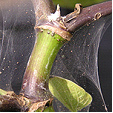
Spruce Spider Mite (Oligonychus ununguis) is a tiny greenish black adult which lays eggs on twigs where they overwinter. The pale green young spiders suck the sap turning the leaves yellow to brown. Heavy infestations form webbing and the pest is found on Abies and Juniperus species.
Banana spider mite (Tetranychus lambi) is a major widespread pest of bananas. It differs from two spotted mite by not producing copious amount of webbing. It is highly active during the dry spring to summer period and with the onset of the wet season mite numbers are reduced. The warm dry conditions that are created under plastic bunch covers is ideal for building up banana spider mite numbers.
Damage is normally confined to the underside of leaves appearing as rusty patches that coalesce along the leaf veins eventually turning the whole leaf brown-grey before it collapses. Fruit is damaged, close to the bunch stalk causing the area to become dull red purple-black, which in turn becomes dry then cracks.
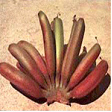 Damage fruit
Damage fruit
Control methods include careful water management during dry periods, and the reduction of dust from roadways. Regular desuckering and leaf trimming of plants will assist with a good coverage when spraying miticides.
Life Cycle
Mites have a gradual metamorphosis, with several nymphal stages. Each female lays up to 100 eggs that hatch in 7-14 days, with several generations appearing throughout the year. Females may become inactive during cold weather.
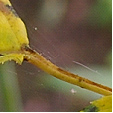 Webbing
Webbing 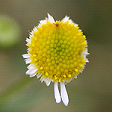
Period of Activity
The Two-spotted mite is most active in hot dry conditions. Under optimum conditions, the population can double every four days. It produces large quantities of webbing for over-wintering nests. Many plants are only susceptible to this insect when cultivated under glass.
Damage Caused
Adults and nymphs lacerated the undersides of the leaves with there rasping mouth parts, although infestations on both surfaces are not uncommon. Infestations cause leaf mottling leaf fall; premature leaf loss causes loss of vigour and reduces the quality and quantity of future crops. Repeated infestations, year after year, may weaken root growth and kill herbaceous plants.
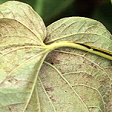
Susceptible Plants
A wide range of plants are attacked by the Red Spider Mite including annuals, fruit trees and vegetables, ornamental shrubs and trees.
Note
Many plant species are more susceptible to Red Spider Mite when they are cultivated under glass.
Other species of mite that are mentioned below have simular characteristics.
Calluna, Rose, Tropaeolum and Viola and species are infested with the Red Spider Mite (Tetranychus telarius) commonly in greenhouse situations.
Musa species are attacked by two spotted mite and banana spider mite damaging foliage and fruit.
Juglans species can be infested with up to four types of mites including red spider.
Cultural Control
Heavy rain or irrigation can reduce numbers; some plants may benefit from replanting in cooler locations. Generally, however, infested material should be completely removed and destroyed.
Preventative measures such as removing weeds or mulching around trees or shrubs or scrubbing the loose bark of susceptible trees during winter helps reduce numbers. During spring sticky bands can be wrapped around trunks close to the ground to trap the mites.
Biological Control
Natural predators include lacewings, ladybirds and thrips help keep the numbers down. Insecticide-resistant predatory mites (Typhlodromus occidenyalis) are also available commercially to control the Two-spotted Mite only on a large scale, as they require ample mites to survive.
Chemical Control
Spraying should be carried out as a last resort as many predators are killed during the operation and spraying can have the opposite effect by increasing numbers in the long term. Dimethoate will reduce numbers; however, Two-spotted mites are resistant to insecticides in some areas. Dusting with wettable sulphur may also prove effective.
Note
Always read the label for registration details and direction of use prior to application of any chemicals.
DISEASE
NAME
Canker (General)
Various Canker Species
Description
This is a fungal problem that enters the plant through wounds causing dieback of twigs and stems.
Symptoms
The stems become discoloured (pale brown) usually from a pruned point, working its way down the stem and normally intersecting or surrounded with live cambium. The bark splits or cracks, foliage dies and infected areas can develop tiny black fruiting bodies. Heavy infected plants eventually die, though certain varieties are resistant halting the spread of the infection.
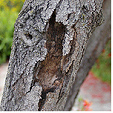
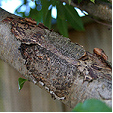
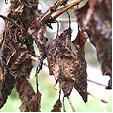
Black Canker (Phyaslospora miyabeana) forms dark brown spots with concentric rings on the upper leaf surface and grey spots on the stems. The tiny black fruiting bodies develop in the stem lesions. It is found on Salix species and persistent attacks will kill the tree.
The Canker (Cytospora valsa) causes the browning and death of branches in Picea abies and Picea pungens. This infection occurs normally from the base of the tree with infected needles falling, and white resinous patches appearing on the bark accompanied by cankers with tiny black fruiting bodies.
The Canker (Corynneum cardinale) is a casual fungus that invades wounds and infects living bark and associated cambium turning the foliage yellowish. As it spreads it girdles the branch killing it and ultimately the top of the tree dies out. Cankers eventually form in the trunk and ooze resin. It is found on Cypress.
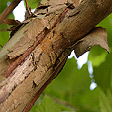 Platanus x hybrida
Platanus x hybrida
Cankerstain (Ceratocystis fimbriata f. platani) forms sunken cankers on the trunk and large limbs forming longitudinal cracks and roughened bark. Infected areas form callus around the margins which dies off and when cut open, dark coloured streaks are revealed extending to the central pith. These streaks then radiate out into uninfected wood resulting in the thinning of the crown and producing unusual small leaves. It is normally transmitted through poor tree surgery techniques and infected tools.
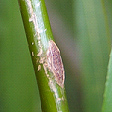 Cytospora Canker
Cytospora Canker
Cytospora Canker (Cytospora chrysosperma) is a casual fungus that infects the young twigs, then moving to the stems, branches and trunk causing brown sunken areas to appear that is covered in red pustules. The fungus tends to attack trees that are in poor health. Control requires the removal of infected branches and improved culture to regain the plants vigour. Sorbus aucuparia, Salix and Popular species are susceptible.
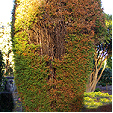 Cypress Canker
Cypress Canker
Cypress Canker (Seiridium species) enters the plant through wounds or through insect damage causes the bark to spread revealing brown powdery spores that are accompanied by oozing resin. The canker eventually girdles the branch or trunk causing ringbarking and the death of the plant.
Nectria Canker (Nectria Cinnabarina) forms cankers on the twigs and small branches producing red fruiting bodies and eventually killing the tree. It is found in many parts of the world infecting a range of trees including hardwoods.
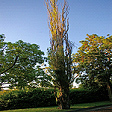
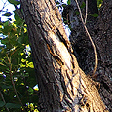
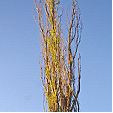 Populus nigra
Populus nigra
Poplar Canker (Cryptodiaporthe populea) infects the cambium layer damaging the bark and sapwood where the elongated sunken canker forms. Branches are girdled causing the upper portion to die off. This is a serious problem for Populus nigra var. Italica entering the plant through wounds or the leaves then spreading to twigs and branches. Control is difficult as removal of infected parts will not eradicate the problem, but encourage it. Young plants may be sprayed with a copper based fungicide to reduce leaf infection and heavily infected plants should be removed the burnt.
Stem Canker of Red Flowering Gum (Sporotrichum destructor) enters through wounds in the bark forming cankers in the trunk and branches, splitting the bark apart, revealing the wood and infesting the surface with powdery spores. This infection causes the leaves to wither and then the branches die, eventually killing the tree.
Stem Canker (Strumella coryneoidea) is a casual fungus that forms on the trunks of trees as a smooth, dispersed or sunken infection. On mature trees the infection sheds the bark with the canker forming callus tissue around the margins and the centre being exposed. These cankers then tend to extend up and down the trunk, only girdling over a long period of time. It is found on Quercus, Fagus, Aesculus species, and Acer rubrum , Nyssa sylvatica, Carya ovata and Morinda citrifolia.
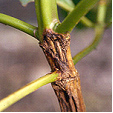
Source and Dispersal
The spores are found on infected dead plant material and can be dispersed by wind and with splashing water.
Favoured Conditions
It prefers a warm humid conditions and plants that have a wounds derived from poor pruning techniques and insect or other damage, especially if water is allowed to settle on the wound.
Affected Plants
Cankers may infect a wide range of trees and shrubs with some species being specific to its host. Examples are listed below.
Abies species are infected by several cankers including (Cytospora pinastri), (Cryptosporium macrospermum) and (Scoleconectria balsamea). These fungi form dead sunken areas on the trunk and branches.
Alnus species are infected by a few cankers including (Nectria coccinea) and (Physalospora obtusa) these attack the branches causing die back.
Betula species may be infected by the Canker (Nectria galligena) that occurs in the forks of trees causing splitting and cracking of the bark by swelling, to reveal the canker. Callus rings may form around the affected areas as a defence mechanism triggered by the tree.
Buxus species are infected by the Canker (Pseudonectria rousseliana) which shows signs of poor new growth during spring with the leaves turning from light green to a tan colour. These leaves tend to lay flat along the stems and reddish pustules appear both on the stems and leaves. The bark becomes loose and on inspection reveals a darkish colour underneath. It is difficult to control and the canker can kill the plant.
Castanea species are infected by the Twig Canker (Cryptodiaporthe castanea), a fungal problem that causes significant damage to the twigs and small branches, but tends to attack stressed trees.
Cercis and Ribes species are infected by the Canker (Botryosphaeria ribis) which forms small sunken areas on the stems causing wilting and eventually killing the branch by girdling. The cankers turn the bark black then split it open and the adjoining wood becomes discoloured. This is a serious problem for this and many other plant species.
Cotoneaster, Betula, Catalpa and Aesculus species are infected by the canker (Physalospora obtusa).
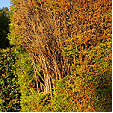
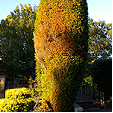 Cypress Canker
Cypress Canker
Cupressus species and Chamaecyparis lawsoniana are susceptible to Cypress Canker (Seiridium species) which causes leaf browning and then girdles the trunks resulting in ringbark. There is also another Canker (Coryneum cardinale) that has simular characteristics and is found in the northern hemisphere.
Cupressus sempervirens is infected by Cytospora Canker (Cytospora cenisia var. littoralis).
Larix species are susceptible to several fungal cankers including (Trichoscyphella wilkommii), (Trichoscyphella ellisiana), (Aleurodiscus amorphus), (Leucostoma Kunzei) and (Phomopsis spp.)
Nyssa sylvatica is attacked by three cankers including (Strumella coryneoidea).
Pinus species are infected by many types of cankers.
Platanus species are infected by Cankerstain.
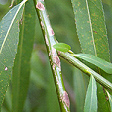 Cytospora Canker on Salix babylonica
Cytospora Canker on Salix babylonica
Pseudotsuga menziesii Douglas Fir is attacked by several cankers including (Cytospora species), (Dasyscypha ellisiana), (Dasyscypha pseudotsugae), (Phacidiopycnis pseudotsugae) and (Phomopsis lokoyae). These infections normally do not require control and are more prevalent on the coastal form.
Salix and Populus species are infected by several cankers including Cytospora Canker (Cytospora chrysosperma), Hypoxylon Canker (Hypoxylon pruinatum), Septoria Canker (Mycosphaerella populorum) and Branch Gall (Macrophoma tumefaciens). Many of these fungi can cause the death of the plant.
Thuja orientalis, Cupressus and Juniperus species are infected by the canker (Corynneum cardinale).
Tilia and Acer species are infected by (Nectria cinnabarina) attacking twigs or branches.
Tsuga species are infected by several cankers including (Dermatea balsamea) and ( Cytospora species).
Ulmus species are infected with up to eight fungal cankers including (Apioporthe apiospora) and (Nectria coccinea).
Vaccinium ovatum is infected by the canker (Coryneum microstictum) which attacks the stems.
Vinca species are infected by canker-dieback (Phomopsis livella) causing the shoots to wilt, turn brown and die. This can reduce the plant to ground level, and normally occurs during rainy periods.
Non-chemical Control
It is very difficult to control and correct pruning techniques with sharp tools for repairing wounds or prune well below the infected areas. Ensure that there are no ragged edges on the cuts and the angle should cut allows water to run off or dress the wound. Plant resistant varieties when available. Heavily infected trees should be removed to avoid spreading the disease.
Improve the culture of the affected plant to increase vigour for greater resistance.
Chemical Control
There is no satisfactory chemical control and prevention is imperative.
Note
Always read the label for registration details and direction of use prior to application of any chemicals.
DISEASE
NAME
Rust (General)
Various Rust Species
Description
Generally this fungal problem involves many species causing a range of symptoms, but generally produces pustules that release reddish - brown spores. Most fungus is specific to its host and normally will not infect other plant species.
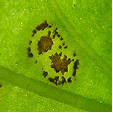 Pustules
Pustules
Symptoms
The upper leaf surface develops red, brown or yellow areas and the underside produces bright yellow to orange spores that correspond to the patches above. Infested leaves become brown in patches, fall prematurely and flower and fruit may also be infected. This overall, results in a loss of vigour and in small plants may lead to death.
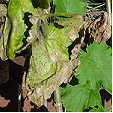 Pelargonium x hortorum
Pelargonium x hortorum
Myrtle Rust (Puccinia psidii) This fungal disease infects plants in the Myrtaceae family and was only recently detected in 2010 and has since spread across eastern Australia from the Northern Territory to Queensland, NSW, Victoria and Tasmania. This rust attacks soft and actively growing foliage or shoots with varying symptoms. It normally starts as small purple spots on the leaves from which spores form in yellow pustules that fade to grey as the infection matures and can merge creating leaf distortion and death of the plant.
The life cycle starts when the powdery yellow spores are distributed by wind to other plants where they germinate and start to grow by piercing the plant cells to obtain nutrients. Germination occurs in dark moist positions with a temperature between 15° to 25°C and the new pustules can release spores in 10 to 12 days, (spores remain viable for 3-months). The spores spread rapidly by wind, water, insects or animals. They are also distributed by plant material, clothing, shoes and vehicles.
 Puccinia psidii
Puccinia psidii
Needle Rust (Melampsora farlowii) infects the new leaves turning them to yellow and fall from the shoot giving the branch a scorched appearance. The fruiting bodies are found on the underside of the leaf and is waxy-red.
Rust in Poplar (Melampsora species). A fungal problem involving at least two species (Melampsora medusae) and (Melampsora larici-idaei).
The upper leaf surface becomes flecked with yellow to light green and the underside produces bright yellow orange spores that correspond to the patches above. Infested leaves become brown in patches, fall prematurely and shoots may die back as a result of not being hardened off to the elements. This overall, results in a loss of vigour and in small plants may lead to death.
The source of the fungus is from other infected plants or fallen leaves and is dispersed by wind.
Host plants include Lombardy Poplars particularly Populus nigra 'Italica' and cottonwoods.
White Rust (Albugo candida) forms snow white pustules that contain colourless spores that turn yellow then brown and are found on the underside of leaves.
White Pine Blister Rust (WPBR) is caused by the fungus (Cronartium ribicola). It is a obligate parasite requiring a living host to survive. The life cycle requires two host species with part of it life on the Pinus species and the other part on Ribes species. First cankers or sores appear on the Pinus species realising spores that land on the Ribes species infecting it. The infection produces a different type of spore that land on the needles and growing branches of the Pinus species and eventually forming cankers. The spores are spread by wind and prefer cool moist conditions. Symptoms include brown spots on the needles and the appearance of dead branches in the crown. Cankers will also appear on the trunk and it tends to attack young trees. Control methods include removal of Ribus species in the affected areas and breading naturally resistant Pinus species.
The Rust (Endophyllum sempervivi) affects Sempervivum species by infecting the young leaves and eventually the crown. The mycelium then travels to the roots and extends into any off shots. Leaves that are infected turn yellowish, grow longer and are thin. Persistent infection may kill the plant.
Source and Dispersal
The source of the fungus is from other infected plants or fallen leaves that contain the fruiting bodies and is dispersed by wind.
Favoured Conditions
Generally rust is more prevalent during summer, preferring warm humid conditions and particularly when the leaves are damp.
Affected Plants
A wide range of ornamental annuals, perennials, ferns, trees, shrubs including, Hibiscus species that are infected by Kuehneola malvicola predominantly in southern USA.
Abies species are infected by many types of rust including (Milesia fructuosa) and (Uredinopsis mirabilis).
Abutilon, Phymosia and Alcea species are infected by the rust (Puccinia heterospora).
Alnus species are occasionally infected with Leaf Rust (Melampsoridium hiratsukanum) which forms yellowish pustules on the leaves that develop turning the leaf brown.
Amelanchler species and Calocedrus decurrens are infected by several rust species including (Gymnosporangium libocedri).
Antirrhinum majus (Snapdragon) is infected by the rust (Puccinia antirrhini). This fungal problem that infects the epidermal layer on the leaf underside, forming pale green areas that are raised and split open revealing reddish brown spores that have a dusty appearance.
As the infestation grows, concentric rings of spore pustules appear around the original infection. The corresponding position on the upper leafs surface turns yellow eventually causing the leaf to wilt and die. The infestation is not restricted to the leaves; all above ground parts of the plant are susceptible and infected plants transmit the fungus dispersing it by wind.
Infected plants should be removed and destroyed.
Anemone and Prunus species are infected by the rust (Tranzschelia pruni-spinosae) that stimulates abnormal growth in the plant during spring.
Aquilegia, Anemone, Delphinium and Clematis species are infected by the Rust (Puccinia rubigo-vera var. agropyri).
Arctostaphylos manzanita is infected by the rust (Pucciniastrum sparsum) occurring in coastal regions but is not normally detrimental to the plant.
Artemisia species are infected by the rust (Uromyces ari-triphylli) which is a systemic disease that is transmitted through seeds. It causes the leaves to turn yellow then die and can infect all parts of the plant except the roots.
Bambusa species are infected by the rust (Dasturella divina) which forms elongated brownish strips on the leaves.
Berberis species may be infected by the Rust (Puccinia graminis) that forms orange spotting on the leaves. It certain regions plants infected with this rust must be removed and destroyed to avoid infecting neighbouring agriculture crops.
Betula species may be infected by Leaf Rust (Melampsoridium betulinum) that forms reddish-yellow spots on the leaves and heavy infestation can defoliate the tree. The host tree changes to Pseudolarix species during the sexual stage and causes blistering of the leaves.
Calendula species may be infected by the Rust (Puccinia flaveriae).
Callistephus and Solidago species may be infected by the Rust (Coleosporium solidaginis) which forms bright yellow spots particularly on new foliage or young plants.
Canna species may be infected by the rust (Puccinia Thaliae).
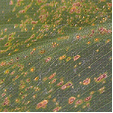
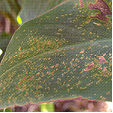 Canna indica
Canna indica
Centaurea species are infected by the rust (Puccinia cyani) and (Puccinia irrequisita) which can cover the stems and leaves.
Cleome species are infected by the rust (Puccinia aristidae) but rarely requires control.
Dianthus species are infected by the rust (Uromyces dianthi) which forms powdery brown spots that appear on both sides of the leaves. The leaves curl and die and the plant becomes stunted. This is a common problem that occurs when grown in a protected enclosure (hot house).
Ficus species are infected by the rust (Cerotelium fici) which forms small brown spots, and causes the leaves to turn yellow then fall prematurely.
Fuchsia species are infected with (Pucciniastrum epilobii). This fungus caused purplish red blotches on the upper leaf surface, that become dry in the middle and result in a brown patch with purple edges. On the underside of the leaf, corresponding to the patches, yellow orange spores form. Heavily infected leaves become yellow and drop prematurely. This leads to a loss of vigour in the plant and infected plants transmit the fungus.
Certain cultivars are more susceptible than others, particularly 'Orange Drops' and 'Novella'.
Hydrangea species is infected by (Pucciniastrum hydrangeae) causing yellowish brown pustules to appear on both sides of the leaf. The leaf becomes dry and brittle.
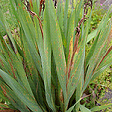
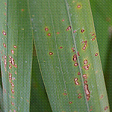 Iris species
Iris species
Iris and Dietes species are very susceptible to the rust (Puccinia iridis). Leaves form rusty red powdery spots that enlarge. They are appear on both sides of the leaves causing the surrounding area to turn pale yellow then brown and the black spores appear soon after, overwintering on dead infected leaves. Plants may be heavily infected but normally survive attack.
Larix species are infected by several Needle Rusts including (Melampsora paradoxa), (Melampsora medusae) and (Melampsoridium betulinum). The fungi attacks the needles predominantly towards the branch tips turning them yellow and eventually killing them . The underside of the leaf develops pale yellow fruiting bodies.
Lupinus species are infected by three species of rust including (Puccinia andropogonis var onobrychidis).
Malus andChaenomeles species may be infected by the rust (Gymnosporangium juniperi-virginianae) or (Gymnosporangium clavipes) which forms brown or bright orange spots on the leaves or twigs and can defoliate the tree. Juniperus virginiana and Mespilus germanica may also be infected by rust.
Mathiola and Arabis species are infected by White Rust.
Pinus species are infects by the Comandra Blister-rust (Cronartium comandre).
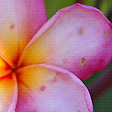
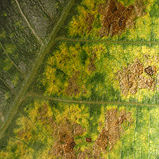
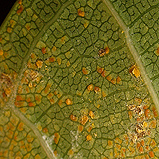
Plumeria rubra Leaf upper surface Leaf underside
Plumeria species are susceptible to the rust (Coleosporium plumeriae). Leaves and flowers may be infected with the underside forming bright yellow pustules and causes premature leaf or flower drop.
Populus nigra 'Italica' is infected by the rust (Melampsora species) which forms pustules to form on the leaves turning them brown and causing premature leaf drop.
Rhododendron and Tsuga species are infected by the rust (Pucciniastrum vaccinii) and is commonly found in nursery stock, spreading rapidly. Tsuga species are also infected by Needle Rust.
Ribes species are infected by the rust (Cronartium ribicola). This leaf rust appears on the underside of the leaves (preferably older leaves) forming dusty brown pustules and is a serious problem. This rust only appears when White Pine (Pinus strobes) grows near where the alternate stage of the fungus occurs.
Rudbeckia species are infected by several species of rust including (Puccinia dioicae) and (Uromyces rudbeckiae).
Salix species are infected by four types of (Melampsora species).
Senecio, Bellis and Calendula species are infected by the rust (Puccinia lagenophora) which forms blister-like pustules that release brown spores.
Sorbus aucuparia is affected by several rust from the (Gymnosporangium species) causing circular yellow spots, that appear on the leaves during summer and develop into orange cup-shaped fruiting bodies.
Trillium species are infected by the rust (Uromyces halstedii) that damages the leaf surface.
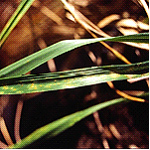 Festuca arundinacea
Festuca arundinacea 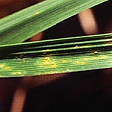 Rust
Rust
Turf Grass are susceptible to rust (Puccinia species) and (Uromyces species), causing yellow flecks to appear on the stems and leaves. These markings enlarge before the pustules form and in severs cases the lawn has a yellow, red or brown appearance.
The infection appears from spring to summer under humid low light conditions and turf that is under stress or with excessive nitrogen in the soil is more susceptible. Many species may be infected including Lolium perenne (Perennial Ryegrass) and Poa pratensis (Kentucky Bluegrass).
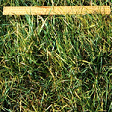
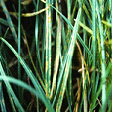 Rust on Perennial Ryegrass
Rust on Perennial Ryegrass
Viburnum species are mildly affected by two types of rust (Coleosporium viburni) and (Puccinia linkii).
Viola species are infected by the rust (Puccinia violae) which forms green spots on the underside of the leaves. It is not commonly seen on cultivated plants.
Non-chemical Control
Cut off and destroy any infected branches, fallen leaves and remove heavily infected plants. Improve the culture by, pruning to improve air circulation, allow space between plants and avoid over crowding. Avoid planting susceptible species. Plants that are infected with a systemic form should be removed and destroyed
Chemical Control
Not possible to spray large trees but young plants may be treated with a protectant fungicide such as wettable sulphur. In a domestic garden small plants such as Fuchsia species may be sprayed with a protectant chemicals as symptoms appear, aided by the removal of existing infected leaves. Under commercial conditions stock may be sprayed with a fungicide such as oxycarboxin.
Note
Always read the label for registration details and direction of use prior to application of any chemicals.
Average Lowest Temperature : -10º C 14º F
USDA : , 6, 7, 8, 9, 10
This USDA (United States Department of Agriculture) hardiness zone chart can be used to indicate a plant’s ability to withstand average minimum temperatures. However, other factors such as soil type, pH, and moisture, drainage, humidity and exposure to sun and wind will also have a direct effect on your plant’s survival. Use this chart only as a guide, always keep the other factors in mind when deciding where, when and what to plant.
A plant's individual USDA zone can be found in the Plant Overview.
Region of origin
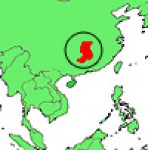
China (Sichuan and Hubei provinces)
Climate Description
Cool to Cold
These zones have low winter temperatures with moderate humidity and moderate summer temperatures.
Frosts and snow are severe. Droughts rarely occur and wind is cold.
Plant growth
Endemic native and exotic cool climate plants grow well within these zones.
| Dictionary | Growth Habit |
| Leaf Type | Botanic Flower Description |
| Leaf Shape | Flower Inflorescence |
| Leaf Arrangement | Fruit Type |
| Leaf Margin | Bark Type |
| Leaf Apex And Bases | Flower Description |